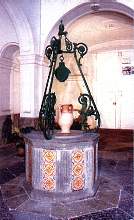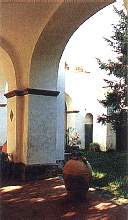Meta di Sorrento
Historical Itinerary
Sun-lit, picturesque and full of historical reminders, Meta gazes down on its harbors from sloping, flowered terraces in one of the most enchanting settings of the Sorrentine Peninsula. As a witness to its ancient origins, there is the presence of Greek and Roman trails and remains, al-be-it fragmentary. The Greeks with the adjective “αλιμρειζ” indicated one of their five landing places on the Sorrentine Peninsular, characterized by the noisy cascading of a waterfall which flowed into the sea at the spot called Alimuri. The frequency of the Greek visits was linked to their commercial exchanges. According to Sergio Attanasio, some trails are of Greek and Roman origin and stem from the original paths between the the pre-existing settlements of Stabia, Pozzano, Scanzano, Vico, Meta. Piano (VIII-II century B.C.) The remains of a Roman cemetery close to the Sanctuary of the Madonna del Lauro attests to the presence of a network of pre-Roman agricultural settlements.
Ancient origins
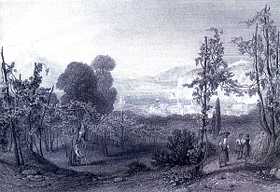 The intensive exploitation of the soil through the farming of the agricultural terraces and the cultivation of olives and grapes seems to go right back to pre-Roman times. Another very ancient area is Pontevecchio with its descent into the glen called Lavinola which goes from Trarivi down to the ruins of Purgatorio. The Alberi Pass, a mountainous stretch called "Mortula" is part of the ancient Roman road to Stabia and is mentioned only in the Angevin Age (1342). The name Meta derives from "miliarus", a stone positioned on the Roman roads to indicate the distance in miles from Rome. Meta, first visited by the Greeks and Romans, was rediscovered in following years by the Goths, the Longobards, the Bizantines and the Saracens. According to Giacinta Jalongo, the first military posts or turrets used for surveying the coast date back to the XI century; the construction of the Sanctuary of the Madonna del Lauro dates back to the X century; the dynamic growth of the hamlets dates back to the X century; the yards for the construction of ships at Alimuri date back to the XII century and the erection of the baroque bell tower next to the Sanctuary dates back to the XVI century. This century (XVI) is the one that dates the evolutionary progress of Meta.
The intensive exploitation of the soil through the farming of the agricultural terraces and the cultivation of olives and grapes seems to go right back to pre-Roman times. Another very ancient area is Pontevecchio with its descent into the glen called Lavinola which goes from Trarivi down to the ruins of Purgatorio. The Alberi Pass, a mountainous stretch called "Mortula" is part of the ancient Roman road to Stabia and is mentioned only in the Angevin Age (1342). The name Meta derives from "miliarus", a stone positioned on the Roman roads to indicate the distance in miles from Rome. Meta, first visited by the Greeks and Romans, was rediscovered in following years by the Goths, the Longobards, the Bizantines and the Saracens. According to Giacinta Jalongo, the first military posts or turrets used for surveying the coast date back to the XI century; the construction of the Sanctuary of the Madonna del Lauro dates back to the X century; the dynamic growth of the hamlets dates back to the X century; the yards for the construction of ships at Alimuri date back to the XII century and the erection of the baroque bell tower next to the Sanctuary dates back to the XVI century. This century (XVI) is the one that dates the evolutionary progress of Meta.
The people of Meta made a great leap forward in the Viceroy Age. The hamlets (whose forerunners the "vici", the "pagi" and the "funda" are reminders of Roman days) grew in size and, tending to stick to the roads, founded a house and road building territory that surrounded the agricultural areas.
1600 and 1700
Look at the old buildings with the spacious courtyards where they sewed and stretched out the sails...
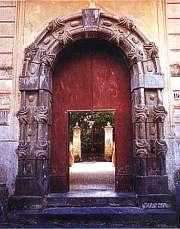 Even if, from 1600 onwards, there had been a notable development in house-building, with the construction of churches and private dwellings, and, in 1800, the cultivation of citrus fruit on the farming terraces which changed the shape of many areas, the modifications have always been done in a way so as not to destroy or alter the existing buildings, therefore preserving the old techniques of construction. Because of this, the centre of Meta, with the presence of monumental buildings both civil and religions, the bidding nucleus of Casa Starita, Pontevecchio,
Even if, from 1600 onwards, there had been a notable development in house-building, with the construction of churches and private dwellings, and, in 1800, the cultivation of citrus fruit on the farming terraces which changed the shape of many areas, the modifications have always been done in a way so as not to destroy or alter the existing buildings, therefore preserving the old techniques of construction. Because of this, the centre of Meta, with the presence of monumental buildings both civil and religions, the bidding nucleus of Casa Starita, Pontevecchio, 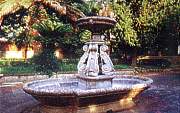 Alberi and the scattered settlements localized in the internal parts, today represent an important historical, artistic and environmental patrimony. Marking the culmination of the progress of Meta was the heroic "age of the sail", the century of the extraordinary achievements of the great families of Meta.
Alberi and the scattered settlements localized in the internal parts, today represent an important historical, artistic and environmental patrimony. Marking the culmination of the progress of Meta was the heroic "age of the sail", the century of the extraordinary achievements of the great families of Meta.
Shipbuilding in Meta
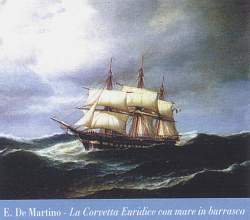 The creation of reforms was the line that linked the Neapolitan shipbuilders to those of Meta. With King Carlo Borbone, the kingdom put shipbuilding at the centre of public attention. This business not only produced wealth, but also developed mechanical and naval art and gave strength to the industry. According to some contemporaries, almost all of the overseas business was in the hands of foreigners (the Dutch, the English and the French) and especially those using the Straits of Gibraltar. Therefore, above all, they looked to England and Holland, who left other nations far behind because they were faithful to the principle "shipbuilding is the wealth of industry". Therefore from the union of the two strength, wealth and glory gushed forth. Giacinto Dragonetti warned "Every non-sailing nation will see its political and domestic interests inferior to those of the sailing nations". To oppose this dependence on the London and other mercantile markets, King Carlo took the road to reform with a series of important productive enterprises joined with opportune legislative measures:
The creation of reforms was the line that linked the Neapolitan shipbuilders to those of Meta. With King Carlo Borbone, the kingdom put shipbuilding at the centre of public attention. This business not only produced wealth, but also developed mechanical and naval art and gave strength to the industry. According to some contemporaries, almost all of the overseas business was in the hands of foreigners (the Dutch, the English and the French) and especially those using the Straits of Gibraltar. Therefore, above all, they looked to England and Holland, who left other nations far behind because they were faithful to the principle "shipbuilding is the wealth of industry". Therefore from the union of the two strength, wealth and glory gushed forth. Giacinto Dragonetti warned "Every non-sailing nation will see its political and domestic interests inferior to those of the sailing nations". To oppose this dependence on the London and other mercantile markets, King Carlo took the road to reform with a series of important productive enterprises joined with opportune legislative measures:
- Easy terms of payment for the construction of new ships.
- Modernization of the ports.
- Royal edict of 18.4.1741 which regulated navigation of the merchant vessels with the obligation to fly the flag of the kingdom.
- A committee of mercantile navigation (1751) with the job of examining all the approved captains, owners and pilots giving them a certificate that enabled the latter to continue the practice of their respective activities. The committee also had to assess the effective sailing conditions and armament of every vessel before sailing. Every owner or captain was obliged to equip his own vessel with four cannons of a caliber corresponding to the size of the ship, and if pirates attacked the ship, owners and sailors that had abandoned the ship had to go to the tribunal of the Consulate of the sea and if they couldnit, they had to go to the Governor of the nearest town and describe the episode in minute detail immediately. The committee established the "right load" to avoid the "throw" should there be a storm; it was common practice for captains to load other goods "above deck".
- Other regulations were emanated in 1751. These imposed the keeping of "one day on board" in which the complete itinerary was described in detail. It sanctioned the absolute prohibition of the abandoning of ships by sailors as well as the discharging of sailors by the captains and owners during the voyage. The number of crew for each type of ship was also decided; 10 - 22 units according to the tonnage expressed in tomoli. The tarriffs for transportation were set according to the cargoe (corn, barley or oil) and according to the destination of the cargoe (within the kingdom or abroad). Also in 1751, King Carlo di Borbone established the maritime arming of two Sciabecchi (small wooden ships) to protect the merchant ships. These were placed on the shipping routes to both other countries and within the kingdom. As well as common piracy, there were cases of retaliation or the arresting of foreign ships like that of Francesco Cafiero's polacca by two royal French frigates while returning from an English port, or that of Gennaro Cacace's polacca by a Spanish sciabeccho.
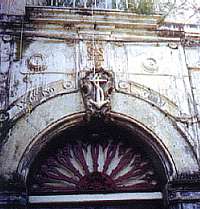 In 1784, two instiutes were inaugurated, oneinMeta, the other in Piano, both had five classes. In 1784 another school opened in Alberi. The whole scholastic programme lasted six years. Every six months the pupils had a general examination; they studied two languages: French and English. At the end of the course the pupils had earned the privilage of being aboard war ships with the qualification of helmsmen for three voyages. Afterwards, they were permanently enrolled in the body of pilots of the Royal Marines. Among the scholastic and athletic subjects at the instiutes, the rules forsaw; swimming, the management of nautical instruments, shrouds and sails, operating the helm and working the sails. Furthermore, the young men had to have a practical knowledge of all the parts of a vessel and the engines. They also had to know use and management of the axe, the hatchet, the chisel and all other tools necessary for the construction of a sailing vessel.
In 1784, two instiutes were inaugurated, oneinMeta, the other in Piano, both had five classes. In 1784 another school opened in Alberi. The whole scholastic programme lasted six years. Every six months the pupils had a general examination; they studied two languages: French and English. At the end of the course the pupils had earned the privilage of being aboard war ships with the qualification of helmsmen for three voyages. Afterwards, they were permanently enrolled in the body of pilots of the Royal Marines. Among the scholastic and athletic subjects at the instiutes, the rules forsaw; swimming, the management of nautical instruments, shrouds and sails, operating the helm and working the sails. Furthermore, the young men had to have a practical knowledge of all the parts of a vessel and the engines. They also had to know use and management of the axe, the hatchet, the chisel and all other tools necessary for the construction of a sailing vessel.
Shipyards of Alimuri
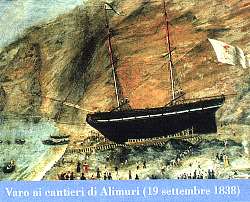 On 31 December 1866, the shipyards of Alimuri that had risen up at the end of 1200 occupied an area of about 9,000 mq. They had eight levels of construction with a need for 240 workers per day. It appears that 256 sailing ships for a total of 64,251 tons were built around that date. The crew of the ship was of an informal nature, where the figure of the owner identified with that of the captain at the command and members of the family identified with even the humblest of the crew. The sailing ships so built, armed and equipped left for the ports of the Mediterranean and Northern Europe, the Baltic, the United Kingdom, North and South America, China and Australia. We must not forget the industry made up from a constellation of craftsmen's workshops, specialized in the making of utensels for the ships as well as containers of various dimensions for the transport via sea of solid and liquid products (Via Cassari) or in the weaving of the sails and in the interlacing of hemp for the shipìs rigging (Cardiento).
On 31 December 1866, the shipyards of Alimuri that had risen up at the end of 1200 occupied an area of about 9,000 mq. They had eight levels of construction with a need for 240 workers per day. It appears that 256 sailing ships for a total of 64,251 tons were built around that date. The crew of the ship was of an informal nature, where the figure of the owner identified with that of the captain at the command and members of the family identified with even the humblest of the crew. The sailing ships so built, armed and equipped left for the ports of the Mediterranean and Northern Europe, the Baltic, the United Kingdom, North and South America, China and Australia. We must not forget the industry made up from a constellation of craftsmen's workshops, specialized in the making of utensels for the ships as well as containers of various dimensions for the transport via sea of solid and liquid products (Via Cassari) or in the weaving of the sails and in the interlacing of hemp for the shipìs rigging (Cardiento).
Dwellings and owners of the old shipyards of Meta
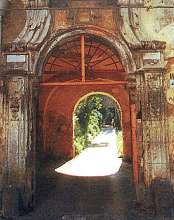 In Meta, the presence of a special atmosphere is easily noted. Placid old-fashioned houses that have nothing in common with modern, middle-class villas, are the houses of the Master Mariners; houses of the ship-owners of the old Neapolitan shipyards,
In Meta, the presence of a special atmosphere is easily noted. Placid old-fashioned houses that have nothing in common with modern, middle-class villas, are the houses of the Master Mariners; houses of the ship-owners of the old Neapolitan shipyards, 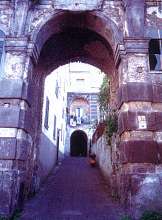 almost all of them built between the second half of 1700s and the end of the 1800s. Often the house opens with a small door adorned with portals in lava stone which contrasts its dark grey colour with the whitewashed facade. On the first floor, which is often also its last, the balconies look out from a stone slab supported by brackets. The most important maritime family surnames are: Astarita, Cafiero, Castellano, Lauro, Maresca, D'esposito, Longobardo, Pollio, Romano, Starita and Trapani.
almost all of them built between the second half of 1700s and the end of the 1800s. Often the house opens with a small door adorned with portals in lava stone which contrasts its dark grey colour with the whitewashed facade. On the first floor, which is often also its last, the balconies look out from a stone slab supported by brackets. The most important maritime family surnames are: Astarita, Cafiero, Castellano, Lauro, Maresca, D'esposito, Longobardo, Pollio, Romano, Starita and Trapani.
The house of the captains
The Maritime Association of Sorrento founded on 1-11-1890 was legally recognized with the following ends in mind: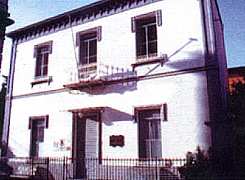
- to promote moral and material betterment of the members;
- to help members who are unable to work through sickness or accident;
- to assist members who have lost or damaged their own ship through accident or other;
- to look after the families of the deceased members.
Historical Itinerary
- Naturalistic Itinerary
- Artistic Itinerary
